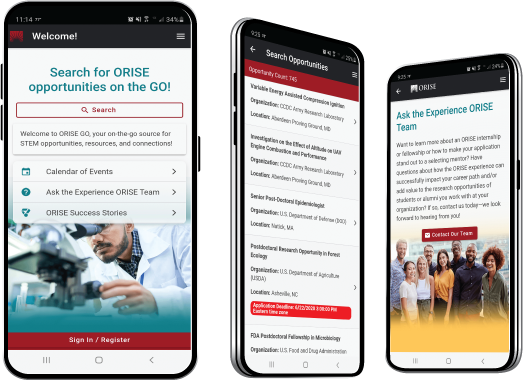Event-based Imagers (EBI) vs. Traditional Frame-based Imagers for Broad-area Anomaly Detection
Create and release your Profile on Zintellect – Postdoctoral applicants must create an account and complete a profile in the on-line application system. Please note: your resume/CV may not exceed 2 pages.
Complete your application – Enter the rest of the information required for the IC Postdoc Program Research Opportunity. The application itself contains detailed instructions for each one of these components: availability, citizenship, transcripts, dissertation abstract, publication and presentation plan, and information about your Research Advisor co-applicant.
Additional information about the IC Postdoctoral Research Fellowship Program is available on the program website located at: https://orise.orau.gov/icpostdoc/index.html.
If you have questions, send an email to ICPostdoc@orau.org. Please include the reference code for this opportunity in your email.
Research Topic Description, including Problem Statement:
Background: Event-based Imagers (EBIs)—also known as neuromorphic cameras, event-based electro-optical (EO) sensors, or silicon retinas—are increasingly being adopted for a variety of applications, especially in Europe where most research and commercialization of EBIs has taken place. EBIs adopt a unique paradigm of asynchronous pixels that supply output to measure log-level changes in intensity, e.g., a series of events with the format (x, y, t, p), where (x, y) is the pixel location, (t) is the timestamp, and (p) is the polarity of the event, meaning (+1/-1) or (1/0) represent whether there was an increase or decrease in light intensity. This change detection occurs in the circuitry of each asynchronous pixel, which enables several benefits characteristic of the EBI-paradigm. These characteristics, at least with EBIs up to quarter video graphics array (QVGA) resolution, include microsecond-level temporal fidelity in the timestamp, 120-plus decibel (dB) dynamic range, multiple orders of magnitude lower data rate, and tens of milliwatts (mWs) lower power consumption. DARPA (as of November 2020) will be executing a program to develop a 2k-by-2k infrared-band EBI that, among other advances, aims to maintain very high timing accuracy and fidelity when outputting a large number of events from a high resolution EBI, while still maintaining a high dynamic range, low data rate, and low power consumption.
Topic/Problem: Due to the novelty and limited proliferation of these sensors (the first “truly commercial” sensor became available for purchase as recently as mid-2018 from Prophesee, a Paris, France-based company), most EBI research has been limited in scope to robotic control and navigation, e.g., small-form factor quadcopters, autonomous vehicles, manufacturing quality control and safety, etc. There is a dearth of research related to high-altitude and space-based uses that could benefit from the unique sensor characteristics this paradigm provides.
Example Approaches:
Explore the collection and performance requirements of Event-based Imagers to collect data of sufficient quality to detect small-scale anomalies in a broad area search application. Develop and compare theoretical system performance metrics against traditional framing imaging systems. Broad area search detection of small-scale events is defined as a sufficient level of information to determine the presence of objects on the scale of vehicles or smaller in areas of 1,000 km^2 or larger. Examples of open ocean anomalies may include small semi-submersible seagoing vessels or a small noncommercial life raft. Examples of terrestrial-based anomalies may include a motorized vehicle in open terrain.
Relevance to the Intelligence Community:
A greater understanding of the tangible and theoretical capabilities and limitations of Event-based Imagers would support investment strategies for organizations interested in any machine vision or other static/persistent or dynamic/visual sensing applications that would benefit from very high temporal fidelity in the timestamp, very high dynamic range, multiple orders of magnitude lower data rate, and/or very low power consumption.
Key Words: Event-based Imagers, Event-based Cameras, Neuromorphic, Neuromorphic Cameras, Silicon Retinas, Infrared Sensors, Low Swap Sensors, Broad Area Search, Anomaly Detection
Postdoc Eligibility
- U.S. citizens only
- Ph.D. in a relevant field must be completed before beginning the appointment and within five years of the application deadline
- Proposal must be associated with an accredited U.S. university, college, or U.S. government laboratory
- Eligible candidates may only receive one award from the IC Postdoctoral Research Fellowship Program
Research Advisor Eligibility
- Must be an employee of an accredited U.S. university, college or U.S. government laboratory
- Are not required to be U.S. citizens
- Citizenship: U.S. Citizen Only
- Degree: Doctoral Degree.
-
Discipline(s):
- Chemistry and Materials Sciences (12 )
- Communications and Graphics Design (2 )
- Computer, Information, and Data Sciences (17 )
- Earth and Geosciences (21 )
- Engineering (27 )
- Environmental and Marine Sciences (14 )
- Life Health and Medical Sciences (45 )
- Mathematics and Statistics (10 )
- Other Non-Science & Engineering (2 )
- Physics (16 )
- Science & Engineering-related (1 )
- Social and Behavioral Sciences (27 )

 ORISE GO
ORISE GO

The ORISE GO mobile app helps you stay engaged, connected and informed during your ORISE experience – from application, to offer, through your appointment and even as an ORISE alum!





